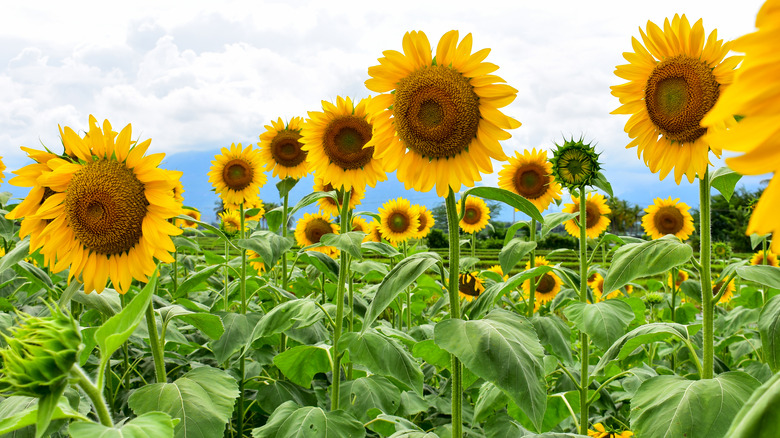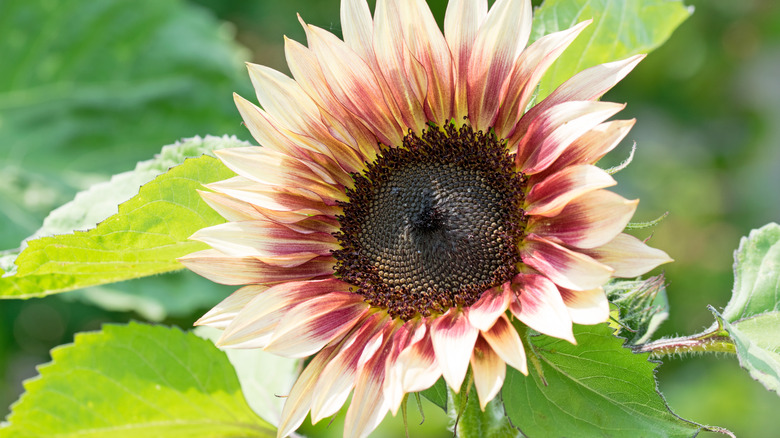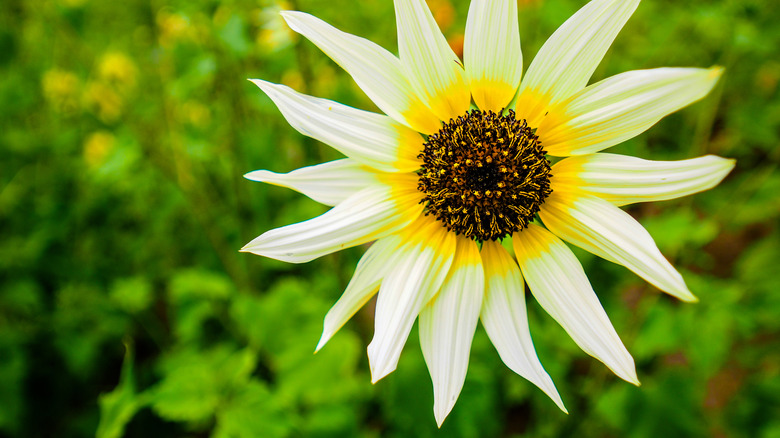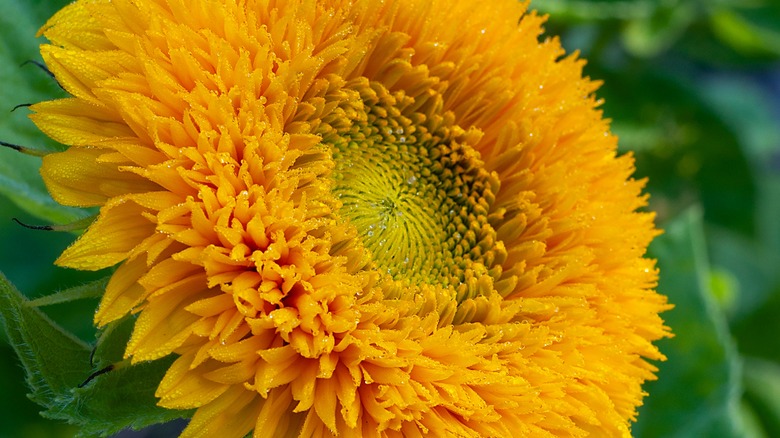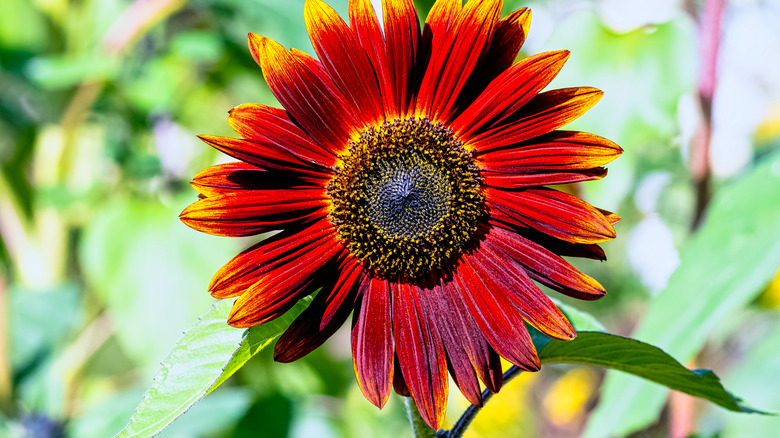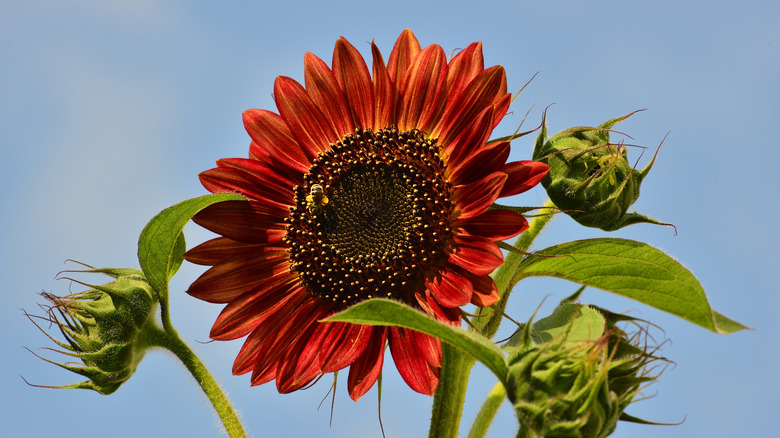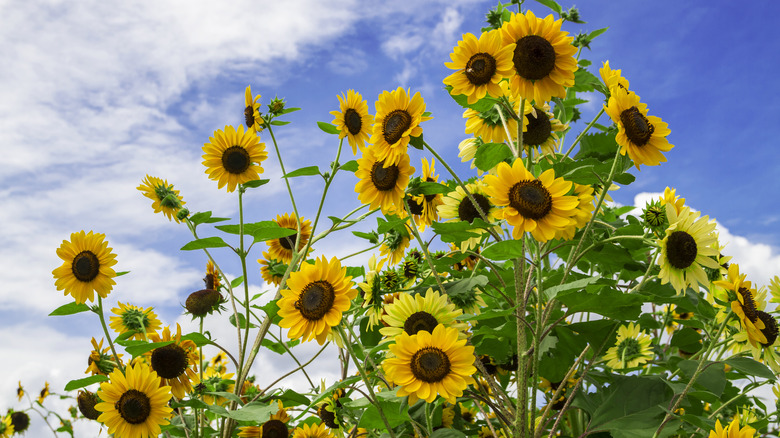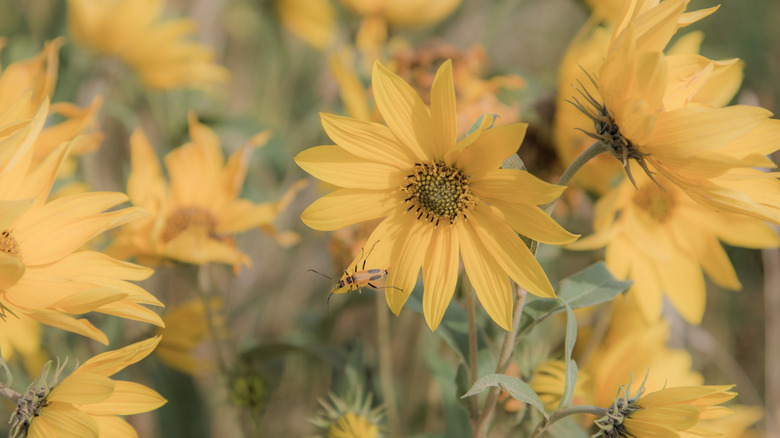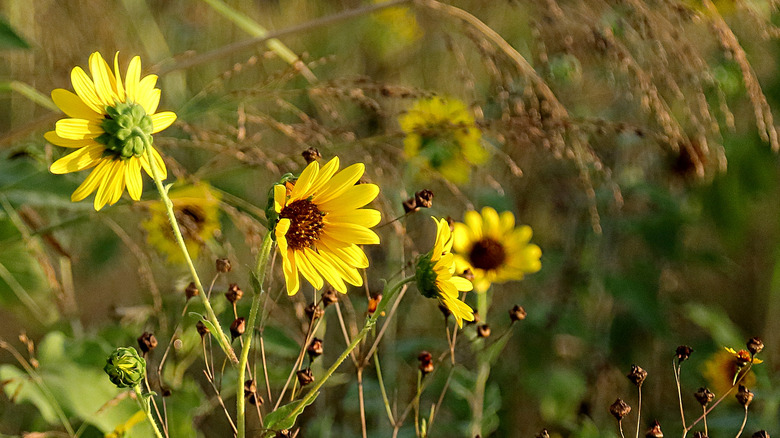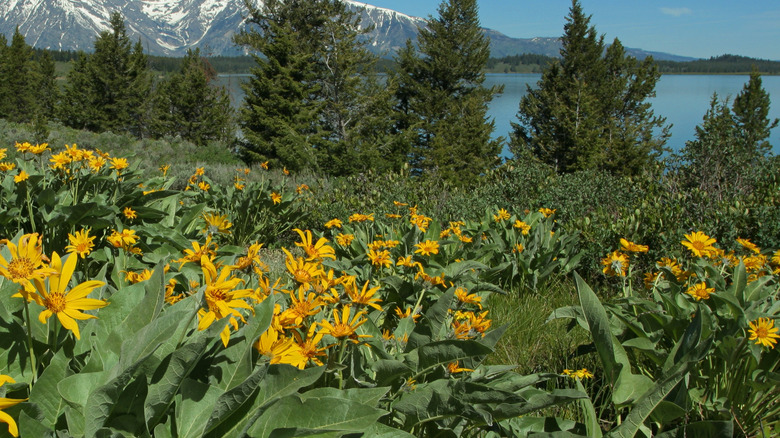10 Stunning Sunflowers That Will Brighten Your Property
Ensuring you have some diversity in your garden is important to prevent similar plants from competing for nutrients, as well as attract more pollinators, decrease pest infestations and reduce weeds, Hoselink recommends. It's also important to bring in different plants with different colors and heights to promote design elements, such as rhythm, balance, and proportion. The perfect addition would be something bright but neutral, such as the beautiful yellow display of a sunflower.
There are plenty of positive reasons to plant sunflowers, such as their ability to attract many bees (which will also benefit the rest of your garden), per The Micro Gardener. They also produce black and gray striped seeds that are edible and high in vitamin E, magnesium, and selenium. As the blooming season nears its end, cutting the long stems and creating a beautiful arrangement for your home is also an option. However, according to She Said Sunflower, some work goes into taking care of these beauties, as they typically need a consistent watering schedule and plenty of sunlight. So, let's take a look at what type of sunflower might be best for you.
1. Russian mammoth
The Russian mammoth (Helianthus annuus) can grow up to 15 feet tall, while the flowers reach 12 to 14 inches wide, per American Meadows. They thrive in USDA zones 1-10 and are noted to be easy to grow and low maintenance. Typically, gardeners will use them as a growing screen or as an amazing background for a garden or meadow. This sunflower is also okay with a variety of soil types and moisture levels.
2. Strawberry blonde
Strawberry blonde (Helianthus annuus) is a gorgeous flower with shades of burgundy pink that circle around the base, as well as pastel yellow tips, per Pinetree Garden Seeds. This variety is able to grow up to 5 to 6 feet and desires soil that is loose yet also rich and well-draining. You should mix compost into the soil before sowing or transplanting, and also be careful not to add too much nitrogen as it can affect how the flower grows. This plant can be found in USDA zones 4-9, per Home Knowledge Base.
3. Italian white
Italian white (Helianthus annuus) produces 4-inch wide flowers with a dark brown center, white petals, and yellow ring at the base, according to Park Seed. The plants bloom from early summer to late summer and can grow anywhere from 5 to 7 feet tall. If you're a lover of birds, you'll also enjoy the little winged creatures this sunflower attracts, including butterflies. Italian white enjoys sitting in dry soil while being hit with direct sunlight, and each flower should be grown 2 to 4 feet apart to allow the space for foliage to grow.
4. Teddy bear
Teddy bear (Helianthus annuus) produces large, yellow sunflowers with a mum-like appearance that can grow up to 6 feet tall, per Terroir Seeds. Due to their ability to provide shade and wind protection, Teddy bears can help safely grow cucumbers and melons and provide shelter for other vegetables. If you sow its seeds from April to mid-June, you'll be able to enjoy the beautiful flowers from mid-summer to late fall, but it does need well-draining soil. This sunflower is found in USDA zones 1-10, per American Meadows.
5. Earthwalker
Earthwalker (Helianthus annuus) is a beautiful copper-colored sunflower with bright, yellow tips, per Eden Brothers. You typically have to plant this variety in the spring in order to enjoy its beautiful blooming season in the summer. Earthwalker has an annual life cycle. It can grow up to 5 feet, and is great at repelling pests if you are growing onion or squash nearby; it's also beautiful next to lupine flowers or cornflowers. It thrives in the USDA zones 1-10 and can tolerate dry conditions and heat.
6. Moulin rouge
Moulin rouge (Helianthus annuus) grows sunflowers that produce a mesmerizing deep red color with a gold ring around the middle, per Seeds Needs. It can grow from 4 to 8 feet tall, with a foliage spread of 18 inches. Luckily, this sunflower can grow in all USDA zones and enjoys hanging out in the full sun. Moulin rouge is sure to elevate the design of your yard, as you can use it as a border plant or place it along your driveway or fence. In addition, this flower blooms during the summer and desires soft and moist soil.
7. Skyscraper
Skyscraper (Helianthus annuus) sunflowers are able to grow a whopping 12 feet high, according to GardenTags. Not only that, but its bright, yellow flowers have a width of 14 inches. Skyscrapers are a little tolerant of heat and drought and only require occasional watering. Usually, this variety needs to be planted in moist and free-draining soil between March and April so that the flowers bloom from mid-May to mid-September. This sunflower is mostly found in USDA zones 3-9, per Gurney's Seed and Nursery.
8. Maximilian
Maximilian sunflower (Helianthus maximiliani) grows dainty, bright yellow flowers that spread to be 5 inches wide, per Wildflower. This plant can reach anywhere between 3 to 10 feet tall, and the flowers grow petals with a slightly pointed tip that leans backward to open up the center. You can enjoy its blooms from the end of summer to November, and it is okay with either dry or moist soil that is clay-like or sandy. This sunflower can be found in USDA zones 3-9 per the USDA.
9. Swamp sunflower
Swamp sunflowers (Helianthus angustifolius) produce symmetrical flowers with rounded edges, per Lady Bird Johnson Wildflower Center. They typically grow anywhere from 1 to 3 feet tall, with 2-inch flowers. They bloom in October, produce a bright, yellow color, and can be found throughout the South and Midwest. If you have a pond, this flower can be a beautiful border around it. It's also able to attract birds and bees. Its soil should be kept wet but it can tolerate a variety of sandy loam textures. This sunflower is found in USDA zones 5-9 per Pond Informer.
10. Western sunflower
Western sunflowers (Helianthus occidentalis) can grow up to 3 feet tall and produce soft, yellow flowers that shape into a slight rosette form, per Prairie Moon Nursery. The flowers bloom from July to September and thrive in USDA zones 3-9. They also enjoy full to partial sun, and the soil should either be medium, medium-dry, or dry. This is a wonderful plant to introduce into your garden if you need to attract pollinators such as bees and butterflies.

